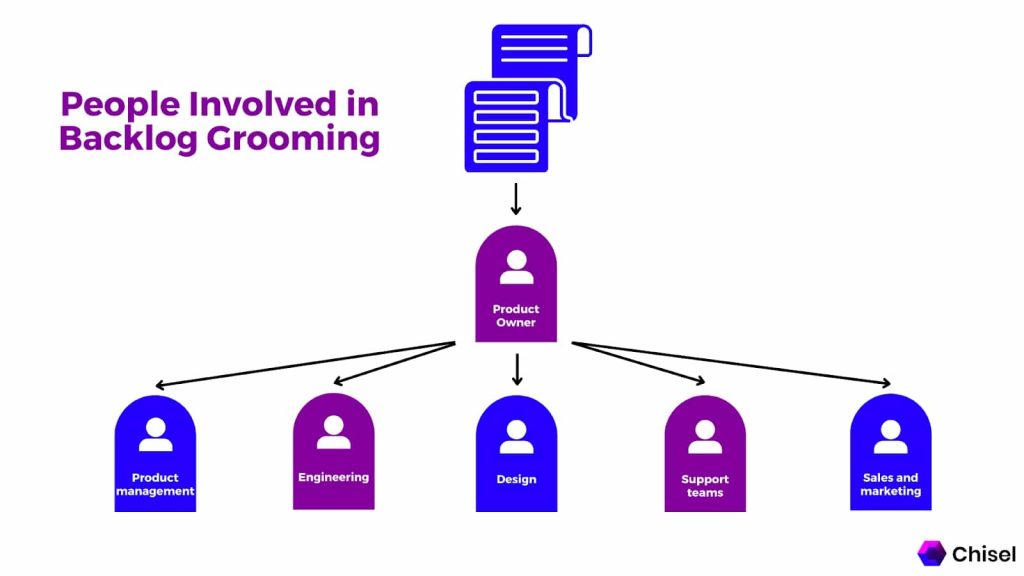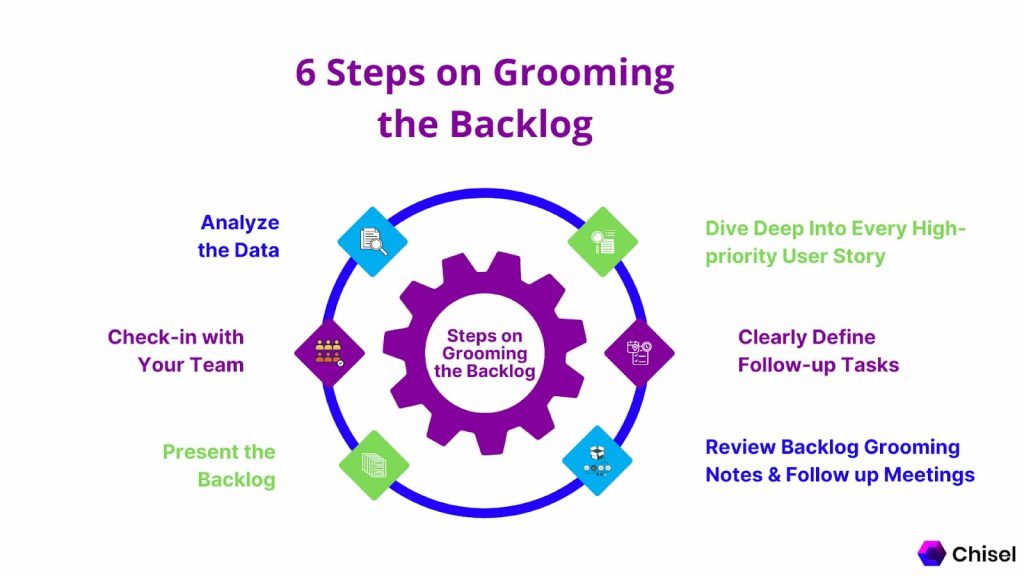What Is Backlog Grooming?

This article covers:
- What Is Backlog Grooming and Why Is It Important for Your Product?
- Who Should Attend Backlog Grooming Sessions?
- Who Should Be Involved in Backlog Grooming?
- How to Identify What Needs Grooming in Product Backlog?
- The Benefits of Backlog Grooming
- Step-by-Step Guide on Grooming the Backlog
- What Are Backlog Grooming Best Practices?
- The Necessity of a Product Backlog Management Tool
You’ve got a lot on your plate as a product manager. You’re working with so many product management tools. Constantly juggling making an up-to-date product roadmap using product roadmap tools, managing your team, and prioritizing features that serve your users.
Nowadays, everyone wants to be in the room when making decisions about what goes into the next release of your app. That means there is one more thing to do: backlog grooming.
With Chisel, you can organize your backlog and prioritize your product roadmap with simple drag-and-drop functionality. Backlog organization makes it easy for teams to understand work progress when things get done. Along with how they impact the business.
This post will explain how you can take advantage of backlog grooming by breaking down its benefits for you and your stakeholders. Better decision-making, improved alignment with business goals, and smoother product rollouts.
What Is Backlog Grooming and Why Is It Important?
Backlog grooming is the process of reviewing and prioritizing your product backlog. It’s a way to make sure you have the right features in your product, that they are well-designed, and that you can deliver them on time. Backlog grooming also helps you manage expectations with stakeholders about what will be delivered when.
If you want to build an amazing product, then it’s important to get this step done early in the process. You’ll save yourself from having too many features or not being able to ship anything at all!
The process also helps ensure that all features in your product backlog are aligned with the strategic goals for your company, team, or project. It also ensures that you have a prioritized list of work to tackle next.
And if there are any problems with your backlog before development starts, now’s the time to fix them so they don’t come back later as surprises for developers or customers.
Who Should Attend Backlog Grooming Sessions?
Backlog grooming is the process of reviewing and prioritizing your product backlog. It’s a way to make sure you have the right features in your product, they are well-designed, and you can deliver them on time.
Backlog grooming also helps you manage expectations with stakeholders about what will be delivered and when.
Getting this step done early is essential to building a fantastic product. You’ll save yourself from having too many features or not being able to ship anything at all!
The process also helps ensure that all features in your product backlog align with the strategic goals for your company, team, or project. It also ensures that you have a prioritized list of work to tackle next.
And if there are any problems with your backlog before development starts, now’s the time to fix them. Make sure they don’t come back later as surprises for developers or customers.
Who Should Be Involved in Backlog Grooming?
A product owner should always be present in backlog grooming. But you would also bring together the following team members to ensure all perspectives get represented:
- Product management
- Engineering
- Design (or design leadership)
- Support teams or customer success managers
- Sales and marketing.
You may find that some of these roles will need help from someone else on their team regarding backlog grooming.
For example, a product manager might want input from engineering if they’re trying to decide between two features. Not everyone knows everything about your product.
Encourage different people in different departments to get involved so you can make better decisions with more information. Backlog grooming helps keep things moving forward without any surprises down the road.

How to Identify What Needs Grooming in Product Backlog?
There are many backlog grooming activities as the breadth of your product expands.
Eliminating or Adding User Stories
The goal is to create a product backlog with the right balance of work-in-progress items and those you can schedule for later.
That way, your team will be able to deliver what has been promised while also planning for future work.
New needs will always come up, and in response, you’ll need to add these to the backlog.
Updating Priorities and Estimates
Now that you have added and eliminated the requisite backlog items, prioritization becomes more critical.
Your team can quickly get disorganized as you continuously add and remove potential items. Due to the absence of a streamlined way to prioritize feature requests or action items.
Backlog grooming helps you prioritize items. Backlog grooming allows you to estimate the complexity and effort of each task. Therefore gives your team an idea of when they can expect a feature.
This process gives everyone on the product team confidence and clarity about what’s coming up and what they need to do next.
Splitting User Stories
After prioritizing all of the different items that you need to complete, there may be user stories that have gotten larger than they should be.
User stories of high priority but too large to fit comfortably in an upcoming iteration usually get split.
Splitting a user story identifies the different pieces and then creates new stories to cover those.
For example, if we had a high-priority user story about adding support for exporting data in .csv format. But this was too large to fit into an upcoming iteration comfortably. You might split that up into two smaller stories.
The Benefits of Backlog Grooming
So we know what backlog grooming is, who is involved, and the most popular strategy to manage accordingly. The biggest question now is, why is it important?
It Increases Efficiency Within the Team
The most important reason to do backlog grooming is to help your team move forward. Productivity increases when you appropriately groom the backlog. Backlog grooming also helps to identify the most critical features of your product.
Back-of-the-envelope estimates are more accurate and reduce the lead times for delivery, increasing throughput. You will also see what needs prioritization next, avoiding scope creep or slipping deliverables.
Shortening lead time is a tangible benefit with backlog grooming as well.
It translates into increased efficiency. Since you have fewer issues that need resolving at any given moment due to this reduction in work on the back burner (aka backlog).
Backlog grooming lets stakeholders know when they should expect new releases from your team. It gets accomplished by better expectations of how much work gets made each sprint. In comparison with having an estimated schedule based on gut feel.
It Keeps the Backlog Manageable
Depending on how your team is structured, many different stakeholders can add items to the backlog.
If you have an efficient, cross-functional organization, you most likely have input coming from all different sorts of people.
That can lead to some duplication in work and the addition of unnecessary items.
Backlog grooming helps with this issue by ensuring that each item is unique and prioritized thoughtfully. It ensures you don’t have two people doing the same thing when one person could do it more efficiently.
Backlog grooming also ensures your team is not wasting their time on low-priority items. Backlog grooming means there will be less overlap between tasks. They were all intentionally planned ahead of time instead of coming up during the sprint.
Ensures Your Team Is up to Date
A groomed backlog helps keep other team members in the loop of where the product team stands regarding different features, improvements, and so on. Backlog grooming is also a great way to ensure that the team is on top of any potential blockers.
- Backlog Grooming helps teams stay in sync with one another, and it ensures that everyone remains updated about what’s coming next.
- Backlog grooming also lets you figure out if there are any blocks ahead for your product before they become an issue. Or even know where you need help from other departments like design or engineering.
- It’s crucial to groom all items within your backlog and keep them current by adding new ones as they come up. This way, nothing falls through the cracks and slips past due dates.
Everyone Can Learn New Information
A variety of people contribute to the product backlog, so it allows everyone to contribute.
It has an intangible net benefit of gaining insight from other team members based on customer feedback.
Step-by-Step Guide on Grooming the Backlog
You’ve prepared a product backlog with clear goals, features, and defined user stories.
Before the meeting about the backlog, create a short agenda that contains at least a list of stories or tickets needing discussion. Loop your team in to add additional points or stories to the agenda.

Step 1: Analyze the Data
Analyzing the feedback and data collected from target users and active customers is the first step in grooming.
This data can either be quantitative, qualitative, or both.
Data points include user feedback, customer interviews and surveys, and product usage data from analytics tools like Google Analytics.
Analyzing quantitative information for you to create a list of stories that need prioritized review is crucial.
In other words, what are your most important features? What concepts should have more design attention? Which ideas do customers seem more interested in?
In this step, team members must share their expertise. You make sure that no one is overburdened with too many tasks. It has double the impact as it allows you to create an effective leadership model.
Step 2: Check-in With Your Team
Aligning your team is crucial to every aspect of the product development process but critical in the backlog grooming process.
Starting with a quick check-in comes down to asking how everyone is doing and feeling today.
Opening up the floor to your team to discuss any particular topics or potentially suggest new feedback topics that weren’t on the agenda otherwise can be invaluable.
You implement this step before the meeting begins. But remember that your team is comprised of people, and make sure you meet people’s emotional needs. It results in a more productive team overall.
Step 3: Present the Backlog
Start by sharing the screen regarding your backlog location. Make it accessible to your team, whether the backlog is on a product management application or a spreadsheet.
Ideally, the presenter (the Product manager or product owner) has prepared the tasks they want to discuss regarding the visible epics and user stories.
In this step, the product owner will share what needs to happen regarding each epic and user story. They may have already shared these with team members ahead of time. Hence they can prepare questions for discussion among everyone present at this meeting.
The idea here isn’t just to talk about features – it’s also a way to keep stakeholder expectations realistic. Anyone who has input into the backlog must know how much work is involved in shipping the items on time. Also, when do you anticipate completing them by (month/quarter).
Because stakeholders now know what they’re investing in, they’re more likely to buy-in.
Step 4: Dive Deep Into Every High-priority User Story
Start with the high-priority stories and work your way down the list.
You can read them out loud or highlight the important points.
You must not do this for every story. It can be pretty time-consuming, but the purpose is to generate feedback from the team.
Now here is where you can dive deep into the technical details.
If there is an engineer and there are many tech-dependent stories, their role will be to take notes and adjust the tickets accordingly.
They will also provide feedback on the different aspects of the story and help prioritize it.
If there is no engineer in the meeting, someone else from your team can take notes on their behalf.
Remember that this is a product owner’s role in gathering feedback for development teams and helping them ask questions about prioritization. So they don’t have to do all of the research themselves.
Next is deciding which user stories are ready to move into sprint planning or demoing at an upcoming stakeholder review meeting? It’s important not to spend too much time dwelling over any story as you need other people’s input.
You should be reviewing each ticket within 15 minutes max, though break up larger stories accordingly if necessary.
Step 5: Clearly Define Follow-up Tasks
Although there is a 15-minute block assigned to the stories, sometimes they will run over.
The average time should be sitting at about five minutes. Anything longer indicates more clarification and preparation are needed, especially if it runs significantly over the allotted time.
In some cases, it’s healthy to have more extended discussions because it can relate to other topics and spawn more user stories.
Even if the user stories need extra preparation, you need to focus on the follow-up tasks with definitive action items for your team.
For example: “Discuss x with Developer” or “Send email to success about y.” It ensures that you don’t lose essential details in the discussion and gives your team a clear understanding of what they need to do next.
Step 6: Review Backlog Grooming Notes & Follow up Meetings (Optional)
Take some time after each backlog grooming session for reflection on how it went.
You might want to go over any meeting minutes from people who could not put their feedback into the initial discussions. Take note of any other talks along.
Sometimes, the most valuable iterations of the product are born out of these grooming sessions.
We recommend potentially going even a step further and recording the sessions and watching them back (as time permits). You do this to make sure you miss nothing.
What Are Backlog Grooming Best Practices?
Make it DEEP:
The abbreviation DEEP, which means detailed appropriately, estimated, emergent, and prioritized, was coined by Agile advocate Roman Pichler. A well-managed backlog looks like this.
Remember your customers:
Backlog grooming requires a guide, and the focus is always on the customer. Consider them a way of prioritizing the backlog. Users can serve as a yardstick for evaluating everything else. Customers are the goal of the product.
Recognize dependencies:
User stories or activities may not be able to begin until another has been finished. If these dependencies aren’t detected, they might interfere with team members and cause delays. When grooming the backlog, be sure to identify any dependencies.
The Necessity of a Product Backlog Management Tool
Backlog grooming is an essential task for any team that wants to improve its products.
The first thing you should know about backlog grooming is that it’s not just a one-time project. You need to complete grooming regularly for your backlog of tasks and bugs to stay manageable.
This article has given you some steps and tools for the backlog grooming process. Contact Chisel, which offers the most efficient product management tools.
Start today by getting organized with Chisel’s free forever plan or upgrade if needed – we’ll help get things started from there.
